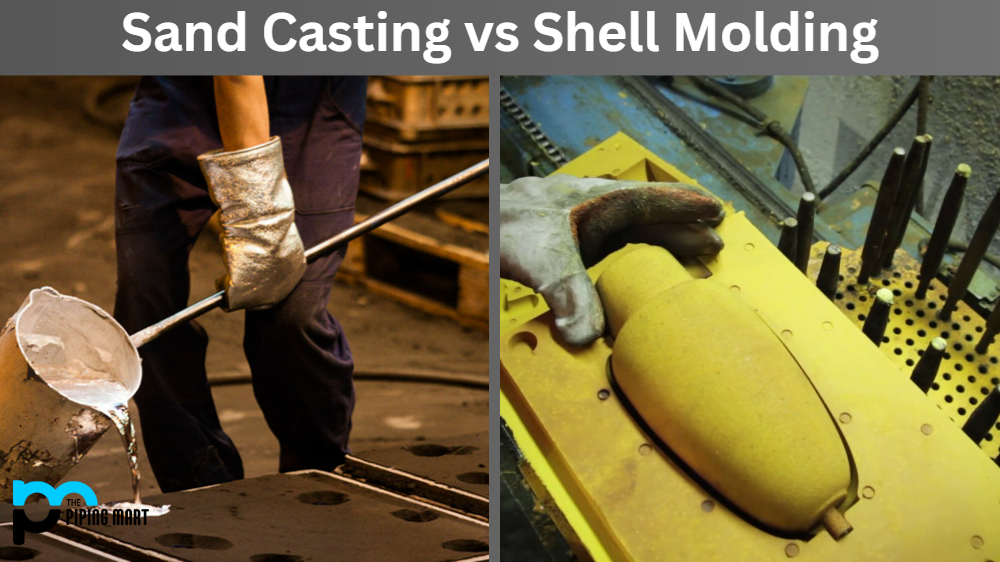In the manufacturing world, many different processes are used to produce castings. Two of the most common are sand casting and shell moulding. While both methods are effective for producing complex parts, there are a few important differences between them that can influence which process is best for your project. Let’s take a look at what sets these two techniques apart from one another.
Sand Casting
Sand casting is a process that involves using sand to form the mold for a metal casting. The sand is mixed with a binding agent and then placed in a mould box. The metal is then poured into the mold and allowed to cool. Once the metal has cooled, the sand mold is broken open, and the metal casting is removed.
Shell Molding
Shell moulding is a process that involves using a shell of sand to form the mould for a metal casting. The shell of sand is placed in a mould box and then heated until it hardens. The metal is then poured into the mold and allowed to cool. Once the metal has cooled, the shell mold is broken open, and the metal casting is removed.
Cost is another essential factor to consider when deciding between these two processes. Since resin-coated moulds used in shell moulding cost more than regular sand moulds used in sand casting, part costs tend to be higher with shell moulding than with sand casting. On the other hand, since shell moulding requires fewer steps and creates less waste material, it can be more cost-effective in the long run due to its efficiency and accuracy.
Another major difference between these two processes lies in their respective capacities for producing large quantities of parts quickly and accurately. While both methods can produce high-quality components quickly, shell moulding can produce larger batches of parts at a much faster rate than sand casting—making it ideal for businesses that need large quantities of components produced quickly and accurately over short periods of time.
Difference Between Sand Casting and Shell Molding
The biggest difference between sand casting and shell moulding is that sand casting involves pouring molten metal into moulds made of sand, while shell moulding uses resin-coated sand moulds to form the desired shape. This makes shell molding more precise than sand casting because it produces less waste material. Additionally, while sand casting requires multiple steps to achieve the desired shape, shell molding only needs one step to create intricate designs with smooth surfaces. This makes producing complex parts with more precise dimensions in shorter production cycles easier and faster.
Advantages of Sand Casting
One advantage of sand casting is that it is relatively simple and does not require expensive equipment. Additionally, sand castings can be made with high precision and detail.
Advantages of Shell Molding
One advantage of shell molding is that it produces castings with smoother surfaces than sand casting. Additionally, shell moulding can be used to make complex shapes that would be difficult to create with sand casting.
Disadvantages of Sand Casting
One disadvantage of sand casting is that it can produce castings with rough surfaces. Additionally, sand castings are typically less precise than shell castings.
Disadvantages of Shell Molding
One disadvantage of shell molding is that it requires expensive equipment and skilled labour. Additionally, shell moulding typically has longer lead times than sand casting.
Conclusion:
When deciding which process is best for your project, consider factors such as part complexity, cost efficiency, size requirements, and production speed. Sand casting may be better suited for projects that require simple shapes or low volumes of parts in shorter production cycles. In contrast, shell moulding may be better suited for those needing complex shapes or high volumes of parts produced quickly and accurately over longer periods. Ultimately, the choice between these two processes comes down to understanding your particular project requirements so you can make an informed decision about which technique will help you achieve your goals most effectively!

Abhishek is a seasoned blogger and industry expert, sharing his insights and knowledge on various topics. With his research, Abhishek offers valuable insights and tips for professionals and enthusiasts. Follow him for expert advice on the latest trends and developments in the metal industry.




